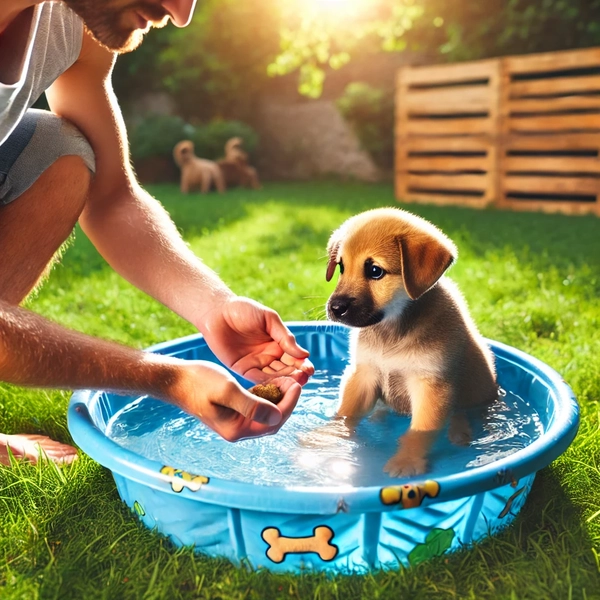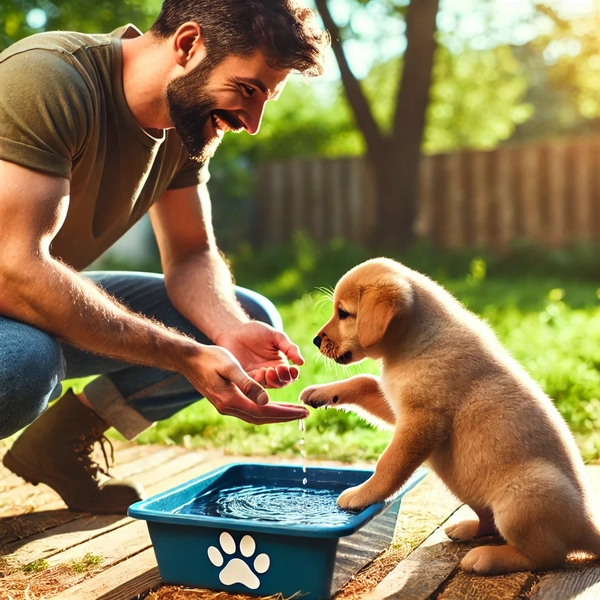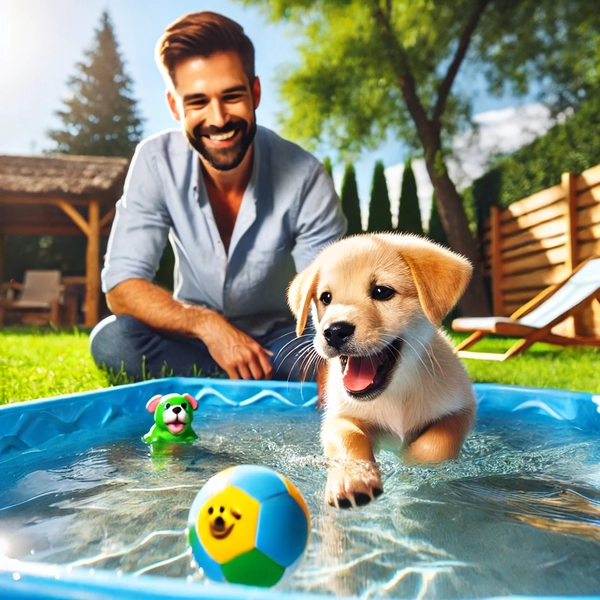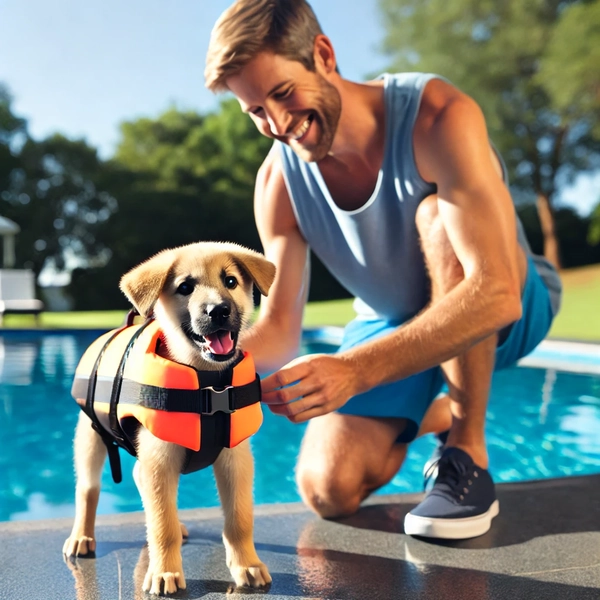How do you introduce a puppy to water? Undoubtedly, most owners enjoy introducing a puppy to water, but one must ensure that this process is gradual and positive.
Whether you want your puppy to love the bath or go to the pool and swim, it’s essential to make every stage happy and safe.
This article gives valuable practices to ensure the puppy has a good attitude and copes well with water.
How to Introduce a Puppy to Water
Here are some tips on how to introduce a puppy to water:
1. Play In Shallow Water At First

If necessary, gradually introduce the puppy to deeper water and hills. The first step in helping the puppy become familiar with the water is to provide shallow and still water.
A good baby pool or the edge of a serene lake would be perfect for this initial stage. Please let the puppies do so at their own pace.
- Let the puppy explore: Allow them to walk around and approach the water without restrictions. They will come to it when they are comfortable and ready.
- Reinforce with Gentle Encouragement: Treats and verbal praises should be given to the puppy whenever it comes close or touches the water. This way, the puppy grows up knowing water as a friendly and pleasurable place.
Helpful Tips:
- Adopt a small, shut, comfortable space without sound or visual interference.
- Pick a time when the place is not busy, such as very early in the day or later in the afternoon.
2. Employ Positive Reinforcement

Positive reinforcement is suitable for elevating the mood while engaging the puppy with water. The concept is to reward the puppy when her calm and curious nature is displayed, especially near or inside the water.
- Give Treats and Compliments: After your puppy makes contact with or even walks into the water, give him a tiny treat and a light praise. This way, your puppy will understand that he is doing something right.
- Do It Even Longer: Always commend and encourage your puppy no matter how little the steps towards the goal are. Consequently, they start perceiving water as a source of pleasure.
Illustrations of Positive Reinforcement:
- To promote dipping the paw in the water, reward the puppy.
- Praise the puppy when inclined to investigate or sniff at the water.
3. Encourage Water Play with Toys

Incorporating toys into the water experience will help to ease them into the water.
Features such as floating toys are appropriate since they entice your puppy to leave the water and play with it.
- Start with Shallow Water: The puppy must be found in water where it is comfortable so a toy can be thrown. This allows them to overcome the fear of going out and entering the water.
- Gradually Increase the Depth of Water: If the puppy adapts, the depth can be increased slowly, and this can be done many times. It should be done carefully so that the puppy does not lose confidence.
Suggested Toys:
- Floating Balls: These are simple for the puppies to swim and catch in the water.
- Retrieving Toys: Ideal for puppies, encouraged to enter the water and retrieve items.
4. Put a Life Jacket on the Puppy

A puppy life vest should be used whenever it is time to try and take your puppy swimming in deeper places, such as a lake or pool.
This provides safety and helps their will as they begin to swim and will be kicking in no time.
- Get the Correct Type: Get a life vest that is not too loose or tight. It should have a handle so you can raise your puppy when necessary.
- First Gym Training: Allow your puppy to wear the jacket for a few minutes at home. This way, they get used to the feeling before entering the water.
Essential Variables:
| Feature | Importance |
| Snug Fit | Prevents the jacket from slipping off. |
| Top Handle | Allows you to lift your puppy safely. |
| Bright Colors | Improves visibility and safety in water. |
5. Be present and show the proper behavior
As puppy owners often speak to them, it is advisable to demonstrate that water is not dangerous.
Enter the water while holding your puppy and remain close so that you can reassure and motivate them.
- Inspire-Negativity: Be playful while splashing water into the surroundings. Your puppy will quickly adjust to your joy and bravely follow you.
- Remain Low: Stand in shallow water, beckoning your puppy to you. This way, you stay close enough to offer encouragement and support, making the water experience less frightening.
Lead By Example Suggestions:
- Utilise melodious tones and smiling faces to convey safety to your puppy.
- Get into the water and carry real or fake objects to demonstrate enjoyment to the puppy.
6. Anything Water Can Be Deeper
After your puppy seems calm and has control in the shallow part of the water, try to take him into the deeper part.
Always take it slow so your puppy can maintain confidence.
- Step-by-step: Assist your puppy in the water for longer and take him further into the deeper water.
- Take a Rest: You should allow your puppy to return to shallow waters for a while. This will enhance its confidence and make it comfortable before venturing deeper waters.
Progression Plan:
- To begin with, each lesson assumes an increase of a couple of inches.
- Always remain within arm’s length of your puppy at all times.
7. Keep an Eye Out to Manage Anxiety Levels
Each puppy has a unique personality, so you should watch them and check whether they are acceptable.
Signs such as trembling, whining or retreating show that your puppy may require a timeout.
- Take It Slow: Do not hurry your pup; if scaring them is possible, just wait. Speak kindly to them and stay a while before letting them do something they fear: water again.
- Promote A Healthy Atmosphere: Ensure your puppy is comfortable by giving them confidence. Be present and speak gently and supportively.
Signs to Watch out for:
- The puppy is visibly shaking or trembling while being near water.
- The puppy is moving to get away from the water or refusing to go into it.
8. Water-Related Commands Practice
Learning to “come” or “stay” commands near water instills safety in your puppy. It is also relaxing for both of you, as you are always in command when water activities are involved.
- Start on Dry Ground: First, carry out dry-land commands so that it is clear to the puppy that all the instructions are understood.
- Reinforce Near Water: As the child becomes acquainted with the commands, he begins training them close to shallow water. This teaches the puppy to obey commands even in a foreign environment.
Useful Commands:
| Command | Use Near Water |
| Come | Keeps the puppy close when exploring water. |
| Stay | Ensures they remain in a safe area. |
The puppy and its owner’s first experience with water should be gradual and positive. This is because taking small steps, praising the puppy, and making it fun at every stage makes it possible for the puppy to learn to love water. Every puppy is unique, so know their rate of progress and ensure that every tiny victory is applauded.